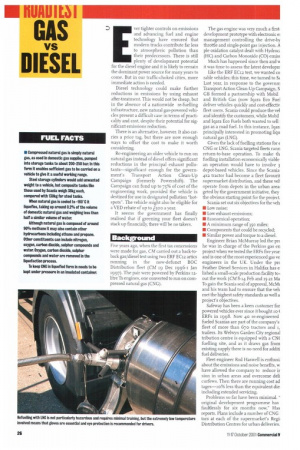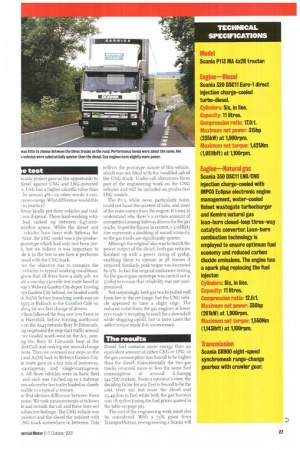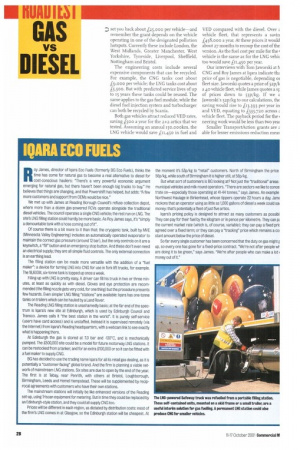FUEL FACTS
Page 26

Page 27

Page 28

Page 30

If you've noticed an error in this article please click here to report it so we can fix it.
• Compressed natural gas is simply natural gas, as used in domestic gas supplies, pumped into storage tanks to about 200-250 bar. In this form it enables sufficient gas to be carried on a vehicle to give it a useful working range.
Steel storage cylinders would add unwanted weight to a vehicle, but composite tanks like those used by Scania weigh 38kg each, compared with 130kg for steel tanks.
When natural gas is cooled to -160"C it liquefies, taking up around 0.2% of the volume of domestic natural gas and weighing less than half a similar volume of water.
Although natural gas is composed of around 90% methane it may also contain other hydrocarbons Including ethane and propane. Other constituents can include nitrogen, oxygen, carbon dioxide, sulphur compounds and water. Oxygen, carbon dioxide, sulphur compounds and water are removed in the liquefaction process.
To keep CNG in liquefied form in needs to be kept under pressure in an insulated container.
ver tighter controls on emissions and advancing fuel and engine technology have ensured that modern trucks contribute far less to atmospheric pollution than their predecessors. There is still plenty of development potential for the diesel engine and it is likely to remain the dominant power source for many years to come. But in our traffic-choked cities, more immediate action is needed.
Diesel technology could make further reductions in emissions by using exhaust after-treatment. This would not be cheap, but in the absence of a nationwide re-fuelling infrastructure, new natural gas-powered vehicles present a difficult case in terms of practicality and cost, despite their potential for significant emissions reduction.
There is an alternative, however. It also carries a price tag, but there are now enough ways to offset the cost to make it worth considering.
Re-engineering an older vehicle to run on natural gas instead of diesel offers significant reductions in the principal exhaust pollutants—significant enough for the government's Transport Action Clean-Up Campaign (formerly Powershift). The Campaign can fund up to 75% of cost of the engineering work, provided the vehicle is destined for use in designated pollution "hotspots". The vehicle might also be eligible for a VED rebate of up to L50o a year.
It seems the government has finally realised that if greening your fleet doesn't stack up financially, there will be no takers.
Background
Five years ago, when the first tax concessions were made for gas, CM carried out a back-toback gas/diesel test using two ERF ECi2 artics running in the now-defunct BOC Distribution fleet (CM 19 Dec 1996-1 Jan 1997). The pair were powered by Perkins 12litre Tx engines, one converted to run on compressed natural gas (CNG).
The gas engine was very much a first. development prototype with electronic e: management controlling the drive-by throttle and single-point gas injection. A ple oxidation catalyst dealt with Hydrocz (HC) and Carbon Monoxide (CO) er111SE Much has happened since then and it was time to assess the latest developrr Like the ERF ECI2 test, we wanted co rable vehicles; this time, we turned to Sc Last year, in response to the governrn Transport Action Clean-Up Campaign, S GB formed a partnership with Mobil and British Gas (now lqara Eco Fuel deliver vehicles quickly and cost-effectiv fleet users. Scania could produce the vel and identify the customers, while Mobil and lqara Eco Fuels both wanted to sell: gas as a road fuel. In this instance, Icjan principally interested in promoting liqu natural gas (LNG).
Given the lack of fuelling stations fore CNG or LNG, Scania targeted fleets rum] return-to-base operation. To make th fuelling installation economically viable an operation would have to involve 3 depot-based vehicles. Since the Scania 4)12 tractor had become a fleet favourit supermarket distribution, and these veloperate from depots in the urban area: geted by the government initiative, they the obvious starting point for the project.
Scania set out six objectives for the veh • Low noise; • Low exhaust emissions; • Economical operation; • A minimum range of 350 miles; • Components that could be recycled; • Similar power and torque to a diesel.
Engineer Brian McMurray led the pr.( he was in charge of the Perkins gas en project when we tested the ERFs five year: and is one of the most experienced gas ye engineers in the UK. Under the prc Feather Diesel Services in Halifax has e lished a small-scale production facility to out the work (CM 8-14 Feb and 15-21 Ma To gain the Scania seal of approval, McMt and his team had to ensure that the veh met the highest safety standards as well a project's objectives.
Safeway has been a keen customer for powered vehicles ever since it bought to c ERFs in 1998. Now 40 re-engineered fueled Scanias are part of the company's fleet of more than 67o tractors and t, trailers. Its Welwyn Garden City regional tribution centre is equipped with a CNC fuelling site, and as it draws gas from existing supply there is no need for additi fuel deliveries.
Fleet engineer Rod Haswell is enthusi, about the emissions and noise benefits, w have allowed the company to reduce ir sion in urban areas and overcome deli curfews. Then there are running cost ad tages—io% less than the equivalent die, including extended servicing.
Problems so far have been minimal." original development programme has faultlessly for six months now," Has reports. Plans include a number of CNG tors at each of the supermarket's Regi Distribution Centres for urban deliveries.
e test
icania project gave us the opportunity to liesel against CNG and LNG-powered s. LNG has a higher calorific value than by around 4%—in other words it conmore energy What difference would this in practice?
Feway kindly put three vehicles and trail: our disposal. These hard-working vehihad racked up between 647.000Dookm apiece. While the diesel and • vehicles have been with Safeway for time. the LNG model was a pre-producprototype which had only just been preJ., but we believe it was important to .de it in the test to see how it performs 3ared with the CNG truck.
Ice the objective was to compare the vehicles in typical working conditions, given that all three have a daily job, we ;ed a one-day 130-mile test route based at vay's Welwyn Garden City depot. Leaving qn Garden City behind, we headed north le AT (M) before branching north-east on ..5 05 at Baldock to the Comfort Café on i6o4 for our first change of drivers.
.? then followed the 604 east into Essex as s Haverhill, before turning north-east on the A43 towards Bury St Edmunds. rig negotiated the stop-start traffic around we headed south-west on the Au, comng the Bury St Edmunds loop at the fort Cafe and making our second change ivers. Then we re-traced our steps on the ; and Ai(M) back to Welwyn Garden City. ie route gave us a fair mix of motorway, -carriageway and single-carriageway s. All three vehicles were in basic fleet and each was hitched up to a Safeway em-axle reefer box trailer loaded as closely )ssible to a typical 31 tonnes.
se first obvious difference between them noise. We took measurements at tickover le and outside the cab and these bore out ;ubjective feelings. The CNG vehicle was luietest and the diesel the noisiest with _NG truck somewhere in between. This reflects the prototype nature of this vehicle, which was not fitted with the modified cab of the CNG truck. Under-cab alterations form part of the engineering work on the CNG vehicles and will be included on production LNG models.
The P113, while never particularly noisy, could not boast the quietest of cabs, and most of the noise comes from the engine. It's easy to understand why there's a certain amount of competition among Safeway drivers For the gas trucks. To put the figures in context, a 3.0c1B (A) rise represents a doubling of sound intensity, so the gas trucks are significantly quieter.
Although the original idea was to match the power output of the diesel, both gas vehicles finished up with a power rating of 35ohp, enabling them to operate at 38 tonnes if required. Similarly, peak torque was increased by 9%. ln fact the original endurance testing for the gas engine prototype was carried out at 37ohp to ensure that reliability was not compromised.
Not surprisingly, both gas trucks pulled well from low in the rev range, but the CNG vehicle appeared to have a slight edge. The reduced noise from the gas engines at lower revs made it tempting to reach for a downshift while slogging uphill, but in most cases the added torque made this unnecessary.
The results
Diesel fuel contains more energy than an equivalent amount of either CNG or LPG, so the gas consumption was bound to be higher than the diesel. Coincidentally the two gas trucks returned more or less the same fuel consumption at around 6.62mpg (42.71itfrookm). From a operator's view, the deciding factor for any fleet is bound to be the cost. Over our test route the diesel cost 25.4p/km in fuel while both the gas burners cost 18.1p/km (using the fuel prices quoted in the table on page 30).
The cost of the engineering work must also be considered. With a 75% grant from TransportAction, re-engineering a Scania will
D set you back about £25,000 per vehicle—and remember the grant depends on the vehicle operating in one of the designated pollution hotspots. Currently these include London, the West Midlands, Greater Manchester, West Yorkshire, Tyneside, Liverpool, Sheffield, Nottingham and Bristol.
The engineering costs include several expensive components that can be recycled. For example, the CNG tanks cost about £9,000 per vehicle; the LNG tanks cost about £5,500. But with predicted service lives of up to 15 years these tanks could be reused. The same applies to the gas fuel module, while the diesel fuel injection system and turbocharger can both be recycled by Scania.
Both gas vehicles attract reduced VED rates, saving L5oo a year for the 2+2 artics that we tested. Assuming an annual r5o,000km, the LNG vehicle would save £11,450 in fuel and VED compared with the diesel. Over vehicle fleet, that represents a savin £458,000 a year. At these prices it would about 27 months to recoup the cost of the version. As the fuel cost per mile for the vehicle is the same as for the LNG vehic too would save £1145o per year.
Our interviews with Tom Jaworski at 11 CNG and Roy James at lqara indicate tha price of gas is negotiable, depending oi fleet size. Jaworslci quotes a price of 52.pik a 40 vehicle fleet, while James quotes a sy of prices down to 53p/kg. If we Jaworsld's 52p/kg to our calculations, the saving would rise to £13,393 per year in and VED, equating to /535,720 across z vehicle fleet. The payback period for the neering work would be less than two yea]
Smaller TransportAction grants are z able for lesser emissions reduction meas too. Equipment such as an oxidation catalyst or a particulate trap retro-fitted to a diesel vehicle would be eligible, so would re-powering with a lower emission engine (eg replacing a Euro-i engine with a Euro-2). Again, to qualify the vehicle must be used in an emissions hot spot.
CONCLUSION
It is clear that operators can save real money by switching to natural gas, and the major practical concerns need not be a problem: the performance of Scania's gas trucks was perfectly acceptable, and they were impressiveh quiet.
But the change to gas will only work if all the conditions are right: these include the level of taxation on the fuel, the infrastructure of refuelling stations and, above all, the availability of grants for the conversion work.
The conversion and standing costs are daunting, so fleet engineers will have to do their sums very carefully before committing to gas power.
• by John Kendall
CONTACTS
Nara Eco Fuels: 14/16 Boulton Road, Reading Berkshire RG2 ONH; 0800 328 6675; tax, 0118 906 2920; web, www.igara.com.
ni Mobil CNG, St Catherine's House, 2 Kingsway, PO Box 394, London WC2B 6W6; 0800 917 4264: fax, 0207 412 4617; e-mail, cntaemail.mobil.com.
• Scania GB, Tongwell, Milton Keynes Bucks MK15 8HB; 01908 210210; fax, 01908 215040; web, www.scania.co.uk.
• TransportAction CleanUp Team, Energy Savings Trust, 21 Dartmouth St, London. SW1H 9BP; TransportAction Hotline, 0845 6021425; fax, 020 7654 2444; web. www.transportaction.org.uk.
The Natural Gas Vehicle Association, PO Box 24, Launceston P115 7XQ; 01579 363803; fax. 0870 167 5066; web, www.natural-gasvehicles.co.uk








































































































































